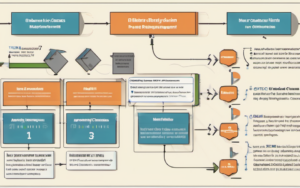The transformative power of blockchain technology is undeniable, and its blockchain impact on traditional financial institutions is rapidly reshaping the landscape. From streamlining processes to enhancing security, the implications are far-reaching and demand careful consideration. This analysis delves into the core features of blockchain, its potential to disrupt various financial services, and the challenges and strategies for traditional institutions navigating this technological shift.
1. Introduction
1.1 The Rise of Blockchain Technology
Blockchain technology, initially conceived as the underlying technology for Bitcoin, has evolved beyond cryptocurrency. Its decentralized, transparent, and secure nature has attracted significant attention across numerous industries, with finance being a prime target. The ability to record transactions immutably on a distributed ledger has captured the imagination of businesses seeking enhanced efficiency and security. This has led to an explosion of interest in exploring its applications for everything from cross-border payments to supply chain management.
1.2 Blockchain’s Potential to Disrupt Finance
The potential of blockchain to disrupt traditional finance is immense. Its inherent security features offer a powerful alternative to existing centralized systems, potentially reducing fraud and increasing efficiency. The ability to automate processes through smart contracts promises to significantly reduce operational costs and streamline workflows. For traditional financial institutions, understanding this potential and adapting accordingly is critical for remaining competitive. Failure to do so could lead to significant market share loss in the future.
1.3 Scope of the Analysis
This analysis will explore the core features of blockchain and their implications for traditional financial institutions. We will examine its impact on various financial services, including payments, securities trading, lending, and asset management. Furthermore, we will discuss the challenges and obstacles faced by traditional institutions in adopting blockchain technology, as well as strategies they can employ to successfully navigate this technological transformation. Finally, we will consider the future implications of this disruptive technology.
2. Blockchain’s Core Features and Their Implications
2.1 Decentralization and its Impact on Trust
Blockchain’s decentralized nature eliminates the need for a central authority, distributing trust across a network of participants. This reduces reliance on intermediaries, potentially lowering costs and increasing transparency. How blockchain technology is disrupting banks is largely due to this inherent distrust of centralized systems. The decentralized nature of blockchain inherently mitigates single points of failure and increases overall system resilience. This directly addresses concerns about censorship and manipulation that are often associated with centralized systems.
2.2 Transparency and Enhanced Auditability
The transparent nature of blockchain allows all participants to view the transaction history, enhancing auditability and accountability. Every transaction is recorded and cryptographically linked to previous transactions, creating an immutable record. This enhanced transparency fosters trust and reduces the risk of fraudulent activities. The ability to easily audit the entire history of transactions is a powerful tool for improving regulatory compliance and risk management.
2.3 Immutability and Data Security
The immutability of the blockchain means that once a transaction is recorded, it cannot be altered or deleted. This enhances data security and provides a strong foundation for building trust and confidence. This feature is particularly crucial in financial systems where data integrity and tamper-proofing are paramount. How blockchain improves financial institution security is largely dependent on its immutability; the record of transactions is effectively tamper-proof.
2.4 Smart Contracts and Automation
Smart contracts, self-executing contracts with the terms of the agreement directly written into code, automate processes and reduce the need for intermediaries. This leads to faster and more efficient transactions, lowering costs and improving transparency. This automation is a game-changer for traditional financial institutions, potentially streamlining everything from loan processing to securities settlement.
3. Impact on Specific Financial Services
3.1 Payments and Remittances
3.1.1 Faster and Cheaper Cross-border Payments
Blockchain facilitates faster and cheaper cross-border payments by eliminating intermediaries and reducing processing times. This is particularly beneficial for remittances, where high fees and slow processing times have historically been significant challenges.
3.1.2 Enhanced Security and Transparency
The enhanced security and transparency of blockchain reduce the risk of fraud and enhance trust in cross-border transactions. The immutable record of transactions provides a clear audit trail, making it easier to track and resolve disputes.
3.2 Securities Trading and Settlement
3.2.1 Streamlined Trading Processes
Blockchain can streamline securities trading processes by automating tasks such as clearing and settlement. This can reduce costs and improve efficiency, leading to faster and more accurate transactions.
3.2.2 Reduced Settlement Times
The use of blockchain can significantly reduce settlement times for securities transactions, improving liquidity and reducing counterparty risk.
3.2.3 Improved Accuracy
Blockchain’s inherent accuracy reduces the incidence of errors in securities trading and settlement, leading to improved operational efficiency and reduced risk.
3.3 Lending and Borrowing
3.3.1 Decentralized Finance (DeFi) and its Implications
Decentralized finance (DeFi) leverages blockchain technology to offer alternative lending and borrowing platforms, bypassing traditional intermediaries. This has significant implications for traditional financial institutions, requiring them to adapt and innovate.
3.3.2 Peer-to-Peer Lending Platforms
Blockchain-based peer-to-peer lending platforms connect borrowers and lenders directly, offering potentially lower interest rates and improved access to credit. This presents both challenges and opportunities for traditional lenders.
3.4 Asset Management
3.4.1 Tokenization of Assets
Blockchain enables the tokenization of assets, allowing for the fractional ownership and trading of assets such as real estate and art. This increases liquidity and accessibility for a broader range of investors.
3.4.2 Fractional Ownership and Increased Liquidity
Tokenization increases liquidity by allowing for the fractional ownership and trading of previously illiquid assets. This can unlock significant value and expand investment opportunities.
4. Challenges and Obstacles for Adoption
4.1 Regulatory Uncertainty and Compliance
Regulatory uncertainty surrounding blockchain technology presents a significant challenge for traditional financial institutions. The lack of clear regulatory frameworks can hinder adoption and create legal risks. The challenges of blockchain adoption in traditional finance are often primarily regulatory in nature.
4.2 Scalability and Performance Issues
Scalability remains a concern for blockchain technology, particularly for high-volume transactions. Performance issues can limit its effectiveness in some applications. Addressing these scalability issues is crucial for widespread adoption.
4.3 Security Concerns and Vulnerabilities
While blockchain technology is inherently secure, vulnerabilities can still exist in its implementation and applications. Security concerns need to be addressed to build trust and ensure the safety of financial transactions.
4.4 Integration with Legacy Systems
Integrating blockchain technology with existing legacy systems in traditional financial institutions can be complex and costly, posing a significant challenge for adoption. Modernizing infrastructure is often a prerequisite to successful integration.
5. Strategies for Traditional Institutions
5.1 Collaboration and Partnerships
Collaboration with fintech companies and blockchain developers can provide access to expertise and resources, accelerating the adoption of blockchain technology. Strategic partnerships can also help mitigate risks and speed up the integration process.
5.2 Internal Development and Innovation
Investing in internal research and development of blockchain solutions can allow traditional institutions to tailor technology to their specific needs. Internal expertise fosters a deeper understanding of the technology and its application within their organization.
5.3 Regulatory Engagement and Advocacy
Engaging with regulators to shape policies and advocate for clear regulatory frameworks is crucial for facilitating the adoption of blockchain technology. Proactive engagement can reduce uncertainty and foster a more favorable regulatory environment.
5.4 Investing in Blockchain Technology
Investing in blockchain technology and infrastructure, including talent acquisition, can strengthen the institution’s position in the evolving financial landscape. Early adoption can provide a competitive advantage and position the institution for future growth.
The future of finance is inextricably linked to the continued evolution and adoption of blockchain technology. Traditional financial institutions that proactively embrace this technology, address the challenges, and strategically integrate it into their operations will be best positioned to thrive in this dynamic environment. The blockchain impact on financial services will continue to unfold, and those institutions that adapt and innovate will undoubtedly benefit the most. Ignoring this technological shift, however, risks irrelevance in the years to come.




